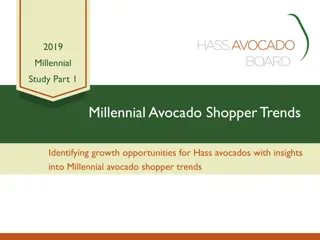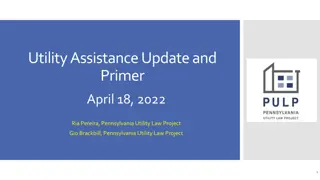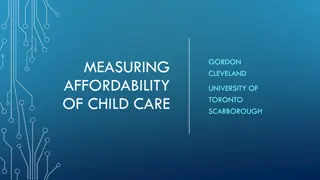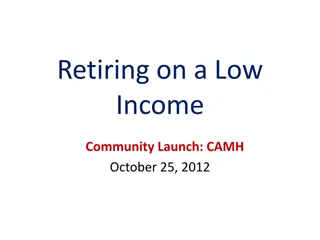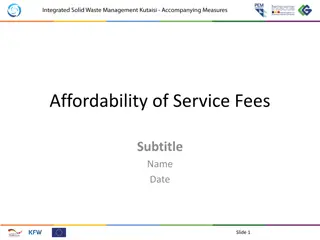Understanding Utility Affordability Challenges for Low-Income Households
Low-income households face significant challenges with utility affordability, especially during COVID-19. The lack of standardized affordability standards and the growing utility debts are exacerbating negative health outcomes and increasing the risk of eviction and homelessness for many families.
Download Presentation

Please find below an Image/Link to download the presentation.
The content on the website is provided AS IS for your information and personal use only. It may not be sold, licensed, or shared on other websites without obtaining consent from the author. Download presentation by click this link. If you encounter any issues during the download, it is possible that the publisher has removed the file from their server.
E N D
Presentation Transcript
The Low Income Household Water Assistance Program (LIHWAP) A Primer for Utility Providers Elizabeth Marx, Executive Director, PULP Brian Whorl, Division Director, Federal Programs, DHS
About PULP: Mission: Assist Pennsylvania s low income families to connect and maintain safe and affordable utility services to their home. Legal Representation Policy Advocacy Education Outreach Technical Assistance
The Importance of Utility Access Image Description: A group of utility services, like electricity and heat, surrounding and connecting to a happy and healthy home.
Utility Unaffordability During COVID-19 Low income households disproportionately so in Black and Latinx communities experienced greatest job loss, food and medicine insecurity, and accrual of debt. Increased household expenses / utility usage required to stay home and stay safe No paid leave / No ability to work from home School-age children at home Reliance on single wage earner and/or fixed income Lack of employer-paid healthcare These same households are also at a higher risk of exposure to COVID-19 and have experienced greater hospitalization rates and death. Substandard housing conditions Greater reliance on service-industry jobs and other public facing / frontline jobs (cleaning, transportation, hospitality, etc) More likely to live in close quarters with others.
Water / WW Affordability Low income households pay as much as 20% of income on water / wastewater / stormwater. No current standardized statewide or national affordability standards for water / wastewater / stormwater. Poverty experts generally agree that combined water / wastewater burden should not exceed 4% of income. EPA has a systemwide affordability standard 2.5% for water; 4.5% for combined water/wastewater EPA s standard relies on median household income and is designed to assess the affordability of system upgrades for small water/ww systems to comply with clean water act requirements. EPA s systemwide affordability standard is NOT designed to assess affordability for low income households.
As of February 2021: Utility insecurity causes deep and lasting harm: 814,000 residential gas, electric, water/ww customers at risk of termination. Exacerbates negative health outcomes Exposure to unhealthy/unsafe temperatures Inability to properly sanitize Lack of clean drinking water Interrupts family unity, children often removed from home Hinders child learning and development Long-term impact on consumer credit Liens (municipal utilities) encumber property, risk of foreclosure Catalyst for eviction, foreclosure, and homelessness Difficulty relocating, ineligibility for public or private housing $852 million in regulated utility debt, up 44% year over year. Increase in utility-related constructive eviction. Terminations began April 1, 2021 for utilities regulated by the PUC. Since April, over 230,000 households lost water, gas, or electricity to their home (PUC regulated). Utility moratoria nationwide reduced COVID-19 infection rates by 4.4% and reduced mortality rates by 7.4%. Source: Duke University, NBER, Working Paper
LIHWAP: Overview Funded by Consolidated Appropriations Act and American Rescue Plan $500 million appropriated by federal government to the states. Pennsylvania received $43.25 million. GRANT ALLOCATION Administrative Cost Outreach Distribution Administered by the Department of Human Services 10% of the allocation will be used for administration. 10% of the allocation will be used for outreach. 80% of the allocation will be used for grant assistance. Administrative Cost 10%Outreach 10% Federal oversight by the Department of Health and Human Services Distribution 80%
LIHWAP: Overview Opens January 4, 2022 Apply at local County Assistance Office or through Compass Program Goal: Reconnect Service and Prevent Termination This is a CRISIS program, not an affordability program! Additional programming being considered as part of federal spending packages to address long-term affordability
LIHWAP: Initial Development Align with Low Income Home Energy Assistance Program (LIHEAP) Assess arrearage levels across the state, in consult with the Public Utility Commission and water/wastewater utilities (regulated and unregulated). Met with stakeholders, including water/wastewater utilities, consumers, and client advocacy groups. Coordinated across multiple bureaus, including the Department of Environmental Protection
LIHWAP: Initial Development DHS received feedback when developing LIHWAP: Draft model plan was available online to receive public comment. Draft was shared with stakeholder groups. 15 individuals and organizations commented on the model plan. Multiple comments supported the Crisis only plan. Used feedback from comments to implement a maximum benefit limit. Feedback helped to develop the rental policy.
LIHWAP: Benefits $25 - $2,500 Grant Grant must either prevent termination or facilitate reconnection. One grant per household, up to maximum $2,500, for each water source. Consumers with separate water/ww providers may apply for a grant for each provider. Grants may cover past due water, wastewater, or stormwater fees.
LIHWAP: Eligibility (1) Income at/below 150% Federal Poverty Level 2021 Federal Poverty Level Guidelines Household Members 1 2 3 4 5 150% FPL $19,320 $26,130 $32,940 $39,750 $46,560
LIHWAP: Eligibility (1) Income at/below 150% Federal Poverty Level Categorical Income Eligibility: Low-Income Home Energy Assistance Program (LIHEAP) A household will be considered categorically income eligible if they received LIHEAP benefits during the 2021-2022 or 2022-2023 LIHEAP seasons. Supplemental Security Income (SSI) Supplemental Nutrition Assistance Program (SNAP) Temporary Assistance for Needy Families (TANF) Categorically eligible households must apply and provide verifications not related to income.
LIHWAP: Eligibility (1) Income at/below 150% Federal Poverty Level Income Exclusions TANF, SNAP, WIC, and Stimulus Payments are all excluded from income. Other exclusions closely mirror LIHEAP income rules. *Check the State Plan and the forthcoming DHS LIHWAP Handbook for other income exclusions!
LIHWAP: Eligibility (2) Household Water/Wastewater Responsibility HHDs in individually metered buildings that are responsible for paying the water/wastewater bill will be eligible for LIHWAP, even if the bill is in the landlord or property owner s name. *Payment must go directly to the water/ww utility to resolve outstanding debts, and cannot be paid directly to the applicant or the landlord. HHDs whose water bill is paid as an undesignated part of rent will not be eligible for LIHWAP. *Emergency Rental (and Utility) Assistance available for these households
LIHWAP: Eligibility (3) Household at Risk of Termination / Service Already Off Households must have existing water arrearages. *Note: Debts may be in the landlord s name, provided there is proof that the applicant is responsible for paying. Termination notice not required.
LIHWAP: Eligibility (4) Vendor must agree to maintain service for a minimum 90 days, even if arrearage amount exceeds available LIHWAP benefit. If the vendor does not agree to accept available LIHWAP benefit, no benefit will be authorized
LIHWAP: Application Process Applications can be submitted to the county assistance office (CAO) online, by mail, in person, or by fax. After an application is received: The application is reviewed to determine if it is complete. Verification is requested from the applicant, if needed. The applicant has 15 days to provide the verification. The application is approved or rejected within 30 days of receipt. The applicant receives a notice explaining the eligibility decision.
LIHWAP: Vendor Agreements Emails to water vendors with the LIHWAP Vendor Agreement began being sent 10/19/2021 Interested water vendors can contact the LIHWAP Vendor Support Unit directly to request a copy by phone at 877-537-9517 or email RA-LIHWAPVENDORS@pa.gov Key items participating vendors agree to: Provide customer s account history and account balance to DHS Restore service within 48 hours of notification of LIHWAP approval (72 hours if digging required, 24 hours if life threatening situation) Immediately apply the LIHWAP payment to a customer s past due bill, deposit, reconnect requirements, or arrearages to eliminate or reduce the amount owed by the customer. Retain water service for at least 90 days from acceptance of payment.
LIHWAP: Vendor Agreements Key items participating Vendors agree to: Help LIHWAP customers enroll in payment agreements or other programs they may be eligible for Not discriminate against customers who receive LIHWAP assistance Not apply LIHWAP payments to account balances that have previously been written off or paid with other funds. Not apply LIHWAP payments to commercial accounts. Key items DHS agrees to: Contact vendors for information about customer accounts Send payments to vendors on behalf of the eligible households via Commonwealth of Pennsylvania Treasury checks or via direct deposit Send lists of customers who receive a LIHWAP grant to the vendor. Notify customer and vendors of the customer s eligibility and total benefit amount.
LIHWAP: Vendor Payments The vendor can chose to receive a paper check or funds direct deposited by EFT (Electronic Funds Transfer) Payments are processed on a weekly cycle. The payment cycle is Friday through Thursday. Treasury begins processing the payments the Friday after the payment cycle, the process takes 8 working days. All payments for the same vendor are written in one check, issued for the total amount of the payment to that vendor for all the clients within the weekly batch. A remittance advice (RA) "voucher" listing the clients for whom the payment is being made and individual client payment amount is printed for mailing or placed on the electronic site for access by the vendors.
Outreach and Training DHS will have flyers posted in CAOs and available for distribution to promote LIHWAP DHS will issue press releases and other media promotion Applicants of other low-income programs will be informed of ability to apply for LIHWAP Vendors are encouraged to notify their customers in danger of termination or with arrearages of LIHWAP
LIHWAP Appeals Applicants have the right to file an appeal and request a hearing about a decision or failure to act that affects LIHWAP eligibility or benefit amount. Applicants are informed of their right to appeal when they complete their application. Information about an applicant s right to appeal is also included in the letter to applicants advising of whether their application was accepted or denied. Appeals must be filed within 30 days of the date of written notice of a CAO decision / action by: completing and signing the appeal section of any notice, sending a written or faxed request to the CAO, telling the CAO and following up with a written request within 3 days, or sending a written request to the agency or CAO that made the determination. Note: Appeals will not prevail if LIHWAP closes because of a lack of funds before the CAO issues benefits or if the applicant submits an application after the program ends. Applicants may be able to cure a denial by submitting required documentation, without going through the appeals process.
OTHER AVAILABLE UTILITY ASSISTANCE PROGRAMS Federal Programs ERAP, HAF, LIHEAP, WAP, Clean and Tune Utility Programs CAP, LIURP, Hardship Funds
Emergency Rental [& Utility] Assistance PA received $847.7M through Consolidated Appropriations Act & American Rescue Plan Act Eligibility 80% Area Median Income Priority for 50% AMI based on 2020 income or at time of application Reduction in income, incurred substantial costs, or experienced financial hardship due to COVID-19 Risk of housing instability / homelessness Benefits Up to 12 mo. rent arrears, plus up to 3 mo. future rent. Additional rent may be provided after 3 months. Up to 12 mo. utility and home energy costs and arrears Electricity, gas, water, sewer, trash, and deliverable fuels (oil/propane/wood/coal) Other housing related expenses incurred directly or indirectly due to COVID-19 Housing stability services Applications available through Compass: https://www.dhs.pa.gov/coronavirus/Pages/Emergency-Rental-Assistance-Program.aspx For counties not using COMPASS, the website will automatically direct applicants to their local ERAP agency
Homeowner Assistance Fund Funded by the federal government through the American Rescue Act Plan Approximately $350 million appropriated to PA. Administered by the Pennsylvania Housing Finance Agency (PHFA) Proposed State Plan Pending Approval by US Treasury Department Includes limited utility relief for energy and water/wastewater. Must apply for other relief first. Process for applications unclear at this time. Program likely to open in winter/spring 2022. Limited pilot program in the works, but pilot will not include utility assistance.
LIHEAP: 2021/2022 Program Year Longstanding federally funded program, administered by DHS. Open October 18, 2021 through May 6, 2022 Cash Grant Minimum $500 / Maximum $1500 Eligibility: Income at/below 150% FPL Pennsylvania resident Home heating responsibility Crisis Grant Minimum $25 / Maximum $1200 Eligibility same as Cash Grant, PLUS Imminent Home Heating Emergency Crisis Interface Repair/replace broken or inoperable heating system or replace/repair service line. Primary heating system must be operational within the last 2 years. Download our annual LIHEAP Webinar (and access other resources) here: https://www.rhls.org/utilities/pulp/links-to-utility-resources/
Weatherization Assistance Program Funded by the Department of Energy Administered in PA by the Dep t of Community and Economic Development Local administration by Weatherization Assistance Providers Eligibility: Household income at or below 200% FPL High priority for households with high energy usage and those with members who are elderly, disabled, or families with children. Renters must obtain landlord approval to participate Benefits: Comprehensive energy efficiency, conservation, and weatherization measures May include minor health and safety repairs More Information Here: https://dced.pa.gov/programs/weatherization-assistance-program-wap/
Clean and Tune Pilot Program The Pa. Dep t of Community and Economic Development launched a pilot Clean and Tune Program on September 1 with funds available through the American Rescue Plan Act. $20 million in assistance available for furnace clean / tune-up, and to provide enhanced weatherization assistance to low income households. Administered by the local Weatherization Assistance Program providers Possible services include: Clean burners, combustion chamber, and heat exchanger surface when accessible Clean and inspect burner orifices and ignition system Check for proper venting and for adequate combustion air (per code) Check and test safety controls Inspect filter, replace standard 1 and 2 filters and/or clean washable filters can provide extra filters as an optional service Run equipment through complete sequence of operation and make adjustments, as necessary Clean and inspect chimneys Replacement of thermostats with programmable option
Customer Assistance Programs Bill Discounts Types of Discounts: Total Bill Discount Fixed Charge Discount Volumetric Charge Discount Percentage of Income Payment Cash Grant Structure Arrearage Management Frozen Debt at Time of Enrollment Arrears frozen and forgiven over time Typically1/36th of arrearage forgiven for each in full payment
Hardship Fund Programs Grant Assistance Typical Terms (Varies by Utility) Income at/below 200% FPL Some utilities increased income threshold temporarily during pandemic Grant amounts vary from $300 to $5oo maximum Must generally be enough to stop termination, alone or with other resources. Advocacy Tip: Combine with other programs, or request payment arrangement for remaining debt. Always ask if utility will accept to prevent termination! Often requires sincere effort to pay or good faith payment This can create barrier for those most in need, without access to family / friends Utilities may waive this requirement in certain circumstances
Low Income Usage Reduction Program FREE energy efficiency measures for gas and electric utility customers. Eligibility: Income at/below 200% FPL High average usage Landlord permission (for renters) Apply: PPL Electric (WRAP): https://www.pplelectric.com/my-account/payments/need-help-paying-your- bill/winter-relief-assistance-program UGI Electric / UGI Gas: https://www.ugi.com/assistance-programs/LIURP/ FirstEnergy (WARM): https://www.firstenergycorp.com/save_energy/save_energy_pennsylvania/west_penn_power/for_ your_home/warm-application.html
Helpful Resources Client-Facing Resources and One-Pagers: https://www.rhls.org/utilities/pulp/links-to-utility-resources/ Pennsylvania Utility Law Project (PULP) pulp@palegalaid.net 717-236-9486 Advocate Questions 844-645-2500 Emergency Utility Hotline Pennsylvania Office of Consumer Advocate https://www.oca.pa.gov/ consumer@paoca.org 800-684-6560 // 717-783-5048 Pennsylvania Legal Aid Network Local Programs https://palegalaid.net/find-legal-help
Helpful Resources DHS LIHWAP Website: https://www.dhs.pa.gov/Services/Assistance/Pages/LIHWAP.aspx LIHWAP Vendor Support Unit (for water providers only) 877-537-9517 RA-LIHWAPVENDORS@pa.gov
Elizabeth Marx Executive Director Pennsylvania Utility Law Project emarx@pautilitylawproject.org Brian Whorl Division Director, Federal Programs Department of Human Services bwhorl@pa.gov














